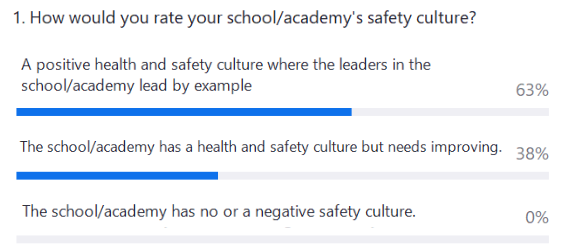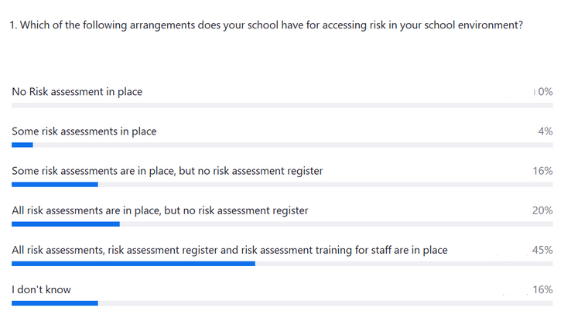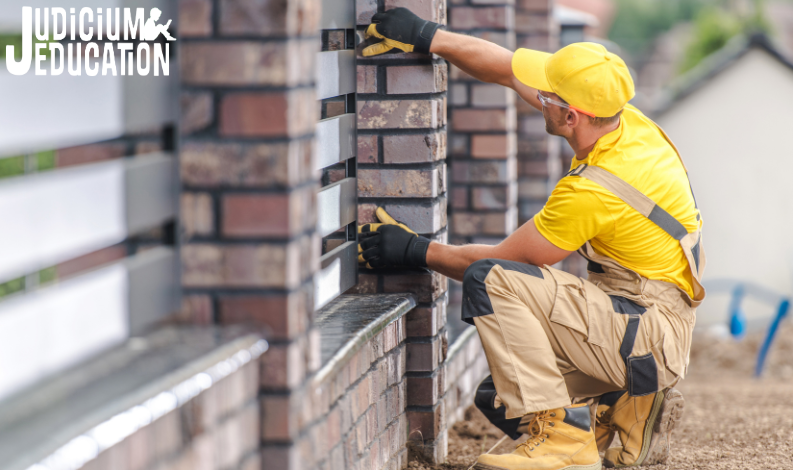School Health and Safety for Governors/Trustees

This blog is based on Judicium’s Health and Safety ‘Sofa Session’ from the 26th of June, with our resident expert Morne Landman, Grad IOSH. This session focused on the legal framework and responsibilities governors/trustees have regarding health and safety, risk assessments, oversight of emergency procedures and how governors can support health and wellbeing in their school or trust.
Poll 1

The Legal Framework and Responsibilities
Health and safety in schools is crucial because it directly affects the wellbeing and productivity of students, staff, and visitors. A safe and healthy environment in your school or trust promotes physical and mental wellbeing, reduces the risk of accidents and injuries, and creates a positive atmosphere for learning and working.
It also instils confidence in parents and the community that the school is a place where their children and staff are cared for and protected. Overall, prioritising health and safety in schools contributes to a more positive educational experience for everyone involved.
The responsibility of health and safety management falls to the Principal/Head Teacher and the governing body. The Principal/Head Teacher and Governors are ultimately responsible for health and safety within the school.
The Governing Body has a collective duty under the below relevant legislation:- Health and Safety at Work etc Act 1974
- Management of Health Safety Regulations 1999
- Regulatory Reform (Fire Safety) Order 2005
- Construction (Design and Management) Regulations 2015
- Occupiers Liability Act 1984.
As a governor/trustee, you have a legal responsibility to report any health and safety concerns you may have to the Head Teacher.
Appointing a designated Health and Safety Governor/Trustee
The Governing Body should lead by example and take ownership of health and safety in their school. That is why they should nominate a governor/trustee who has a sufficient level of knowledge to have responsibility for monitoring and reporting back on matters of health and safety.
The roles and responsibilities of governors/trustees in ensuring compliance with health and safety regulations
The Governing Body's role is to assist school management in developing a good health and safety culture. They have ultimate responsibility for health and safety but should delegate the specific health and safety tasks to suitably competent employees in the school.
The nominated governor should link with the named health and safety representative of the school and be a member of the Governing Body committee managing health and safety matters.
To ensure health and safety is being effectively managed the nominated governor should complete the following tasks:- Termly visits
- Review both health and safety and fire risk assessment action plans to monitor progress towards completion of any recommended improvements.
- Monitoring and Review - Assist in the monitoring and review of the school health and safety policy, ensure this is completed annually and presented to the relevant committee followed by the Governing Body.
- Ensure suitable risk assessments are carried out as set out in the health and safety policy and these are reviewed annually with suitable procedures put in place to manage risks.
- Training & Competence – check staff received sufficient training.
- Monitor procedures such as fire drills, accident statistics and results of surveys such as the Asbestos Management survey and Legionella/Water management survey.
- Ensure an annual documented health and safety audit is carried out. This may be completed by an external advisor or suitably competent employee.
- Communication - Keep the Governing Body informed of health and safety issues.
- Be aware of health and safety implications of matters under consideration by the Governing Body and ensure these are understood before a decision is taken.
- Attend the Governing Body committee meeting where health and safety matters are received and discussed.
- Ensure all relevant documentation arising from such meetings are made available by the Clerk to all governors prior to meetings.
Poll 2

Risk Assessments
The process of conducting a risk assessment in school involves 5 steps:- Identify the hazards
- Decide who might be harmed and how
- Evaluate the risks and decide on precautions
- Record your findings and implement them
- Review your assessment and update it if necessary
The school must ensure a risk assessment register is in place that covers all activities within the school. The school should ensure risk assessments are accessible in a central point so staff and governors/trustees can access risk assessments when required. Providing staff with access to risk assessments allows them to be aware of potential hazards, understand the associated risks, and take appropriate precautions to ensure the safety of students, staff, and visitors within the school environment.
It is recommended that risk assessments are completed by the person responsible for the specific area within the school/trust. This approach ensures the person conducting the risk assessment understands the particular risks and hazards associated with their area and can effectively identify and address them.
By assigning the responsibility to the person in charge of the area, they are likely to have a better understanding of the potential risks and the appropriate control measures needed to mitigate those risks effectively. Involving the person responsible for the area also promotes ownership and accountability for the safety of that particular space or activity. They can proactively identify and implement measures to minimise or eliminate risks, conduct regular inspections, and update the risk assessment as needed.
Common hazards
- Working at height risk assessment
- Playground areas are not supervised, and per playground risk assessment
Reviews
Regular reviews of risk assessments and actions are crucial to managing risks effectively. It's important to continuously monitor and update risk assessments to ensure they remain accurate and reflective of any changes in the school's environment or activities. This proactive approach helps to minimise potential hazards and contributes to the overall health and safety culture within the school.
Emergency Procedures
Comprehensive emergency procedures and oversight over these, including fire drills, lockdown drills, and evacuation plans, is critical. Some good questions to ask include:- Does the school have effective emergency evacuation procedures?
- Do all staff know their role during an evacuation?
It is good practice for the H&S Governor/trustee to attend an emergency evacuation practice at least once per year.
It’s also important staff and governors understand their roles and responsibilities during emergencies:- All staff should be aware of their responsibilities and have sufficient experience, knowledge and training to perform the tasks required.
- Clear procedures to assess significant risks are fully implemented and safe working practices are adopted.
Governors/trustees should be familiar with the school's emergency contact information and chain of communication.
Discuss the school business continuity plan, ensuring key roles and responsibilities and contact information is up to date.
Health and Wellbeing
Promoting good physical and mental health among students and staff is crucial for creating a positive and supportive learning environment.
A good wellbeing culture could promote awareness on nutrition, physical activity, counselling services, and mental health awareness.
Governors play a significant role in supporting these initiatives by implementing policies which prioritise the health and wellbeing of students and staff. Some examples include anti-bullying initiatives, mental health awareness and wellbeing programs.
The main goal is to ensure the health, safety, and wellbeing of students, staff, and visitors. Implementing a clear role of responsibilities and producers will ensure staff is supported to implement and work in line with individual policies and procedures.
Key Top Tips
- The importance of health and safety and the role of governors/trustees in ensuring a safe learning environment and workplace through leadership and strategic planning.
- The importance of having suitable policies and procedures which outline the role and responsibilities of the Governors/trustees.
- Always consider how Governors/trustees can assist in ensuring legal requirements are met, e.g., by monitoring risk registers, emergency procedures, health and wellbeing initiatives, etc.
Helpful Links:
Judicium Education’s Health and Safety Advisory Service is designed to support schools, firstly, in ensuring a safe working and learning environment, secondly, in complying with the legal requirements imposed on them as employers under the various Health & Safety laws and regulations. For more information, please visit here.
If you require any support in any of these steps, or would like to talk to someone surrounding some support for your school please do not hesitate to call us on 0207 336 8403 or email Georgina.decosta@judicium.com.
The Health and Safety Service is also providing accredited training courses, including eLearning with specific modules ranging from courses designed for premises managers and SLT to all staff offerings and fire warden training: https://www.judiciumeducation.co.uk/elearning
We also offer live, exclusive training options: https://www.judiciumeducation.co.uk/training
To review Judicium’s forthcoming sofa sessions please click here.
Follow us on Twitter - @JudiciumEDU
© This content is the exclusive property of Judicium Education. The works are intended to provide an overview of the sofa session you attend and/or to be a learning aid to assist you and your school. However, any redistribution or reproduction of part or all of the contents in any form is prohibited. You may not, except with our express written permission, distribute or exploit the content. Failure to follow this guidance may result in Judicium either preventing you with access to our sessions and/or follow up content.
Related content

This prestigious award celebrates our commitment to delivering expert, education-specific Health & Safety support that lifts the burden for school teams while raising safety standards across the sector.

This blog is based on Judicium’s Health and Safety ‘Sofa Session’ from the 2nd of July, with our resident expert Jonathan Friend and India Cottenden.

This blog is based on Judicium’s Health and Safety ‘Sofa Session’ from 18th June, led by resident expert , Mike Wright, CMIOSH. This session focuses on the control of substances hazardous to health (COSHH) and their relevance in school settings, how assessments should be undertaken and what staff could be at risk.

Discover why Judicium has been shortlisted for Fire Safety Consultancy of the Year at the 2025 FSM Awards, recognising our expert support for schools and trusts in delivering sector-specific, compliant, and practical fire safety solutions.
.png)
This blog is based on Judicium’s Health and Safety ‘Sofa Session’ from the 12th of March, with our resident expert Mike Wright.

This blog is based on Judicium’s Health and Safety ‘Sofa Session’ from the 26th of February, with our resident expert Loretta Igbe.

H&S